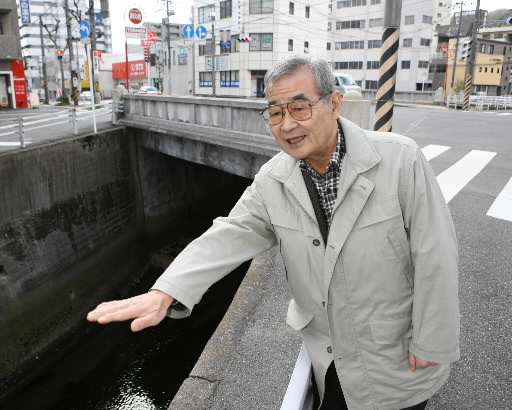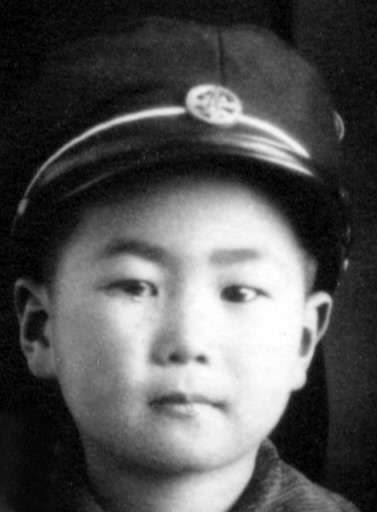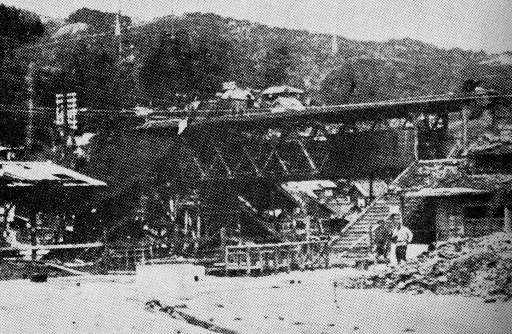Shohei Maesue, 76, Saeki Ward, Hiroshima
Apr. 18, 2014
Fled from black rain, sought shelter beneath a bridge
Too young to aid the many wounded
Shohei Maesue experienced the atomic bombing at his home in Koi-cho, Hiroshima, part of present-day Nishi Ward, about 2.5 kilometers from the hypocenter. At the time the atomic bomb was dropped, on the morning of August 6, 1945, he was 8 years old and in the second grade. Accompanying his father, who served as a civil defense volunteer, Mr. Maesue went to Koi Station (part of present-day Nishi Ward) and the Sakaimachi district (part of present-day Naka Ward), and the sights he saw still haunt him. “I was too young to do anything to help. It’s clear that the atomic bombing was a crime against humanity. I oppose any sort of military conflict,” he said with conviction.
When the bomb fell, he was at home with four members of his family. His father was getting ready to leave for work at his pharmacy in Sakaimachi. One sister, who was four years older, had remained at home because of illness instead of taking part in work for the war effort. Another sister, seven years older, had just returned home after missing the train to Miyajima, where she had been mobilized to work. Mr. Maesue was chatting with this sister and his mother at the front door.
There was a great flash that lit up the whole house, which rocked on its foundation. The windows of the house shattered and the earthen walls collapsed. The house pitched to one side and the doors wouldn’t open. They managed to escape the wreckage, though, then were caught in the dark, radioactive rain that fell shortly after the explosion. Mr. Maesue’s short-sleeved shirt and shorts became wet and black, and the family fled to a spot beneath a bridge that spanned the Yahata River, which flowed in front of their house.
Hearing the news that many injured people had fled to the area around Koi Station, his father decided to head in that direction to help, despite the rain that still fell. Joining his father, Mr. Maesue saw people whose clothes and skin were dangling from their bodies in tatters, making it hard to distinguish their identity, and others with gaping head wounds. Many of them were unable to move from where they had come to rest, probably relieved just to reach the station. He was impressed seeing his father nursing the victims with supplies he had taken from the house.
Because of raging fire on August 6, they were unable to enter the Sakaimachi district. They tried again the next day, on August 7, and found only rubble where his father’s pharmacy had once stood. From a piece of glass that had melted like candy, thought to be from a cabinet, they located the spot where the building had been. They dug out some medicine from the basement and gave these supplies to the government. Two aunts on his father’s side, who lived near the pharmacy, went missing.
After the war, Mr. Maesue and other children would stop vehicles of the Allied Forces in Japan when they drove down the main street near his house, asking them for gum and chocolate. “We said, ‘Those Australian soldiers in their cowboy hats are stingy, so let’s go to the American soldiers.’” he recalled. “No one talked about the United States dropping the atomic bomb.”
He got married in 1967. The following year his first child, a daughter, was born, and after he confirmed that she was in good health, he confessed to his wife, Junko, that he was an atomic bomb survivor. But she replied, “I already knew.”
In recent years he has come to feel that it is important to share accounts of the atomic bombing with the next generation. This sentiment was stirred by a book he read about the military history of Hiroshima from the Meiji Period to the end of World War II. He said, “I want to be able to explain to people, whose loved ones were soldiers and were killed in the bombing, where these soldiers were and what they were doing based on information about their unit.” (Rie Nii, Staff Writer)
Hiroshima Insight
Koi Station: Most of the station building was destroyed
During the war, today’s Nishihiroshima Station, run by the Japan Railway Company, was called Koi Station, and Hiroden Nishihiroshima Station, run by the Hiroshima Electric Railway, was called Nishihiroshima Station or Koi. Both stations were about 2.4 km from the hypocenter.
According to the Record of the Hiroshima A-bomb Disaster, Koi Station, part of the National Railway back then, was largely destroyed in the A-bomb blast. The 20 or 30 staff members of the station crept out from the wreckage to the train tracks. Because of the black rain that fell in the aftermath, damage from fire was minimal. As the bomb was dropped after both the inbound and outbound trains had left the station before 8 a.m., there were few passengers in the station at the time.
After the blast, thousands of people fled the city center. Many died on the grounds of the station and the bodies were cremated in an air-raid shelter nearby, with railroad ties.
The Sanyo Line was restored by the National Railway on August 8. A streetcar line, the Miyajima Line operated by the Hiroshima Electric Railway, was unable to continue service between Nishihiroshima and Kusatsu Station on August 6, but the streetcar continued running between Kusatsu and Miyajima. The next day, streetcars began running end to end on the Miyajima Line, carrying many survivors. Another streetcar line in the city center, between Koi and Nishitenma (present-day Tenmacho) resumed operations on August 9.
Teenagers’ Impressions
Maintaining compassion for others
Mr. Maesue himself suffered hardships, like losing his home, but he tried to help by offering water to someone who was fleeing the city center. However, his father stopped him, because the bomb had contaminated the water supply. I imagine Mr. Maesue felt frustrated because he wasn’t able to do anything to help. I want to be like Mr. Maesue, who maintained compassion for other people despite the dreadful conditions. (Miyu Okada, 13)
Becoming an adult who helps others
“I didn’t survive on my own.” I was impressed by this remark from Mr. Maesue. In the aftermath of the bombing, many soldiers and nurses, from places in and out of Hiroshima Prefecture, came to help with the relief efforts. After the war, supplies were delivered from the United States.
When I grow up, I want to keep in mind that my life is supported by others and offer my help to those in need. (Shiori Niitani, 15)
Staff Writer’s Notebook
After the war, Mr. Maesue had to give up the idea of going to college because of financial reasons. When his health is poor, he wonders whether the cause could be his exposure to the atomic bomb. “But I don’t want to say that it’s because of the atomic bomb,” he said, not wishing to blame the atomic bombing for the life he has led. At the same time, he told us that the voices of the A-bomb survivors have helped prevent nuclear weapons from being used again. Therefore, he stressed the importance of continuing to convey the consequences of a nuclear attack. “Some people have criticized the use of the wax figures of the survivors in Peace Memorial Museum, calling them a cruel sight, but the reality was even more horrific,” Mr. Masesue said. “If the figures are removed, I think they should be displayed in another location.” (Rie Nii)
(Originally published on March 24, 2014)
Too young to aid the many wounded
Shohei Maesue experienced the atomic bombing at his home in Koi-cho, Hiroshima, part of present-day Nishi Ward, about 2.5 kilometers from the hypocenter. At the time the atomic bomb was dropped, on the morning of August 6, 1945, he was 8 years old and in the second grade. Accompanying his father, who served as a civil defense volunteer, Mr. Maesue went to Koi Station (part of present-day Nishi Ward) and the Sakaimachi district (part of present-day Naka Ward), and the sights he saw still haunt him. “I was too young to do anything to help. It’s clear that the atomic bombing was a crime against humanity. I oppose any sort of military conflict,” he said with conviction.
When the bomb fell, he was at home with four members of his family. His father was getting ready to leave for work at his pharmacy in Sakaimachi. One sister, who was four years older, had remained at home because of illness instead of taking part in work for the war effort. Another sister, seven years older, had just returned home after missing the train to Miyajima, where she had been mobilized to work. Mr. Maesue was chatting with this sister and his mother at the front door.
There was a great flash that lit up the whole house, which rocked on its foundation. The windows of the house shattered and the earthen walls collapsed. The house pitched to one side and the doors wouldn’t open. They managed to escape the wreckage, though, then were caught in the dark, radioactive rain that fell shortly after the explosion. Mr. Maesue’s short-sleeved shirt and shorts became wet and black, and the family fled to a spot beneath a bridge that spanned the Yahata River, which flowed in front of their house.
Hearing the news that many injured people had fled to the area around Koi Station, his father decided to head in that direction to help, despite the rain that still fell. Joining his father, Mr. Maesue saw people whose clothes and skin were dangling from their bodies in tatters, making it hard to distinguish their identity, and others with gaping head wounds. Many of them were unable to move from where they had come to rest, probably relieved just to reach the station. He was impressed seeing his father nursing the victims with supplies he had taken from the house.
Because of raging fire on August 6, they were unable to enter the Sakaimachi district. They tried again the next day, on August 7, and found only rubble where his father’s pharmacy had once stood. From a piece of glass that had melted like candy, thought to be from a cabinet, they located the spot where the building had been. They dug out some medicine from the basement and gave these supplies to the government. Two aunts on his father’s side, who lived near the pharmacy, went missing.
After the war, Mr. Maesue and other children would stop vehicles of the Allied Forces in Japan when they drove down the main street near his house, asking them for gum and chocolate. “We said, ‘Those Australian soldiers in their cowboy hats are stingy, so let’s go to the American soldiers.’” he recalled. “No one talked about the United States dropping the atomic bomb.”
He got married in 1967. The following year his first child, a daughter, was born, and after he confirmed that she was in good health, he confessed to his wife, Junko, that he was an atomic bomb survivor. But she replied, “I already knew.”
In recent years he has come to feel that it is important to share accounts of the atomic bombing with the next generation. This sentiment was stirred by a book he read about the military history of Hiroshima from the Meiji Period to the end of World War II. He said, “I want to be able to explain to people, whose loved ones were soldiers and were killed in the bombing, where these soldiers were and what they were doing based on information about their unit.” (Rie Nii, Staff Writer)
Hiroshima Insight
Koi Station: Most of the station building was destroyed
During the war, today’s Nishihiroshima Station, run by the Japan Railway Company, was called Koi Station, and Hiroden Nishihiroshima Station, run by the Hiroshima Electric Railway, was called Nishihiroshima Station or Koi. Both stations were about 2.4 km from the hypocenter.
According to the Record of the Hiroshima A-bomb Disaster, Koi Station, part of the National Railway back then, was largely destroyed in the A-bomb blast. The 20 or 30 staff members of the station crept out from the wreckage to the train tracks. Because of the black rain that fell in the aftermath, damage from fire was minimal. As the bomb was dropped after both the inbound and outbound trains had left the station before 8 a.m., there were few passengers in the station at the time.
After the blast, thousands of people fled the city center. Many died on the grounds of the station and the bodies were cremated in an air-raid shelter nearby, with railroad ties.
The Sanyo Line was restored by the National Railway on August 8. A streetcar line, the Miyajima Line operated by the Hiroshima Electric Railway, was unable to continue service between Nishihiroshima and Kusatsu Station on August 6, but the streetcar continued running between Kusatsu and Miyajima. The next day, streetcars began running end to end on the Miyajima Line, carrying many survivors. Another streetcar line in the city center, between Koi and Nishitenma (present-day Tenmacho) resumed operations on August 9.
Teenagers’ Impressions
Maintaining compassion for others
Mr. Maesue himself suffered hardships, like losing his home, but he tried to help by offering water to someone who was fleeing the city center. However, his father stopped him, because the bomb had contaminated the water supply. I imagine Mr. Maesue felt frustrated because he wasn’t able to do anything to help. I want to be like Mr. Maesue, who maintained compassion for other people despite the dreadful conditions. (Miyu Okada, 13)
Becoming an adult who helps others
“I didn’t survive on my own.” I was impressed by this remark from Mr. Maesue. In the aftermath of the bombing, many soldiers and nurses, from places in and out of Hiroshima Prefecture, came to help with the relief efforts. After the war, supplies were delivered from the United States.
When I grow up, I want to keep in mind that my life is supported by others and offer my help to those in need. (Shiori Niitani, 15)
Staff Writer’s Notebook
After the war, Mr. Maesue had to give up the idea of going to college because of financial reasons. When his health is poor, he wonders whether the cause could be his exposure to the atomic bomb. “But I don’t want to say that it’s because of the atomic bomb,” he said, not wishing to blame the atomic bombing for the life he has led. At the same time, he told us that the voices of the A-bomb survivors have helped prevent nuclear weapons from being used again. Therefore, he stressed the importance of continuing to convey the consequences of a nuclear attack. “Some people have criticized the use of the wax figures of the survivors in Peace Memorial Museum, calling them a cruel sight, but the reality was even more horrific,” Mr. Masesue said. “If the figures are removed, I think they should be displayed in another location.” (Rie Nii)
(Originally published on March 24, 2014)











